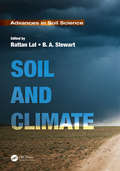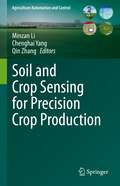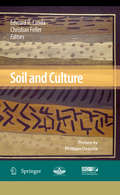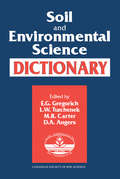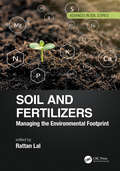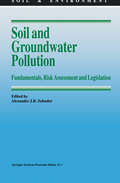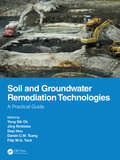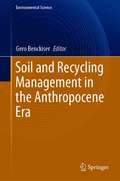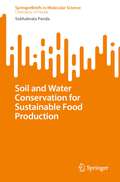- Table View
- List View
Soil and Climate (Advances in Soil Science)
by Rattan Lal B. A. StewartClimate is a soil-forming factor and soil can mitigate climate change through a reduction in the emissions of greenhouse gases and sequestration of atmospheric CO2. Thus, there is a growing interest in soil management practices capable of mitigating climate change and enhancing environmental quality. Soil and Climate addresses global issues through soil management and outlines strategies for advancing Sustainable Development Goals (SDGs). This volume in the Advances in Soil Science series is specifically devoted to describe state-of-the-knowledge regarding the climate–soil nexus in relation to: Soil Processes: weathering, decomposition of organic matter, erosion, leaching, salinization, biochemical, transformations, gaseous flux, and elemental cycling, Soil Properties: physical, chemical, biological, and ecological, Atmospheric Chemistry: gaseous concentrations of (CO2, CH4, N2O), water vapors, soot, dust, and particulate matter, Mitigation and Adaptation: source and sink of GHGs (CO2, CH4, N2O), land use and soil management, soil C sink capacity, permafrost, Soil Management: sequestration of organic and inorganic C, nutrient requirements, water demands, coupled cycling of H2O, N, P, S, and Policy and Outreach: carbon farming, payments for ecosystem services, COP21, SDGs, land degradation neutrality Special topics on soil as a source or sink of CO2, silicate weathering and carbon sequestration, nutrients required for carbon sequestration, physical protection and the mean resident time, and predicting soil carbon stocks are discussed in detail throughout the book.
Soil and Climate: Advances In Soil Science (Advances in Soil Science #Vol. 96)
by Rattan Lal B. A. StewartClimate is a soil-forming factor and soil can mitigate climate change through a reduction in the emissions of greenhouse gases and sequestration of atmospheric CO2. Thus, there is a growing interest in soil management practices capable of mitigating climate change and enhancing environmental quality. Soil and Climate addresses global issues through soil management and outlines strategies for advancing Sustainable Development Goals (SDGs). This volume in the Advances in Soil Science series is specifically devoted to describe state-of-the-knowledge regarding the climate–soil nexus in relation to: Soil Processes: weathering, decomposition of organic matter, erosion, leaching, salinization, biochemical, transformations, gaseous flux, and elemental cycling, Soil Properties: physical, chemical, biological, and ecological, Atmospheric Chemistry: gaseous concentrations of (CO2, CH4, N2O), water vapors, soot, dust, and particulate matter, Mitigation and Adaptation: source and sink of GHGs (CO2, CH4, N2O), land use and soil management, soil C sink capacity, permafrost, Soil Management: sequestration of organic and inorganic C, nutrient requirements, water demands, coupled cycling of H2O, N, P, S, and Policy and Outreach: carbon farming, payments for ecosystem services, COP21, SDGs, land degradation neutrality Special topics on soil as a source or sink of CO2, silicate weathering and carbon sequestration, nutrients required for carbon sequestration, physical protection and the mean resident time, and predicting soil carbon stocks are discussed in detail throughout the book.
Soil and Crop Sensing for Precision Crop Production (Agriculture Automation and Control)
by Minzan Li Chenghai Yang Qin ZhangSoil and crop sensing is a fundamental component and the first important step in precision agriculture. Unless the level of soil and crop variability is known, appropriate management decisions cannot be made and implemented. In the last few decades, various ground-based sensors have been developed to measure spatial variability in soil properties and nutrients, crop growth and yield, and pest conditions. Remote sensing as an important data collection tool has been increasingly used to map soil and crop growth variability as spatial, spectral and temporal resolutions of image data have improved significantly in recent years. While identifying spatial variability of soil and crop growth within fields is an important first step towards precision management, using that variability to formulate variable rate application plans of farming inputs such as fertilizers and pesticides is another essential step in precision agriculture.The purpose of this book is to present the historical, current and future developments of soil and crop sensing technologies with fundamentals and practical examples. The first chapter gives an overview of soil and crop sensing technologies for precision crop production. The next six chapters provide details on theories, methods, practical applications, as well as challenges and future research needs for all aspects of soil and crop sensing. The last two chapters show how soil and crop sensing technologies can be used for plant phenotyping and precision fertilization. The chapters are written by some of the world’s leading experts who have contributed significantly to the developments of precision agriculture technologies, especially in the area of soil and crop sensing. They use their knowledge, experiences, and successful stories to present informative and up-to-date information on relevant topics. Therefore, this book is an invaluable addition to the literature and can be used as a reference by scientists, engineers, practitioners, and college students for the dissemination and advancement of precision agriculture technologies for practical applications.
Soil and Culture
by Edward R. Landa Christian FellerSOIL: beneath our feet / food and fiber / ashes to ashes, dust to dust / dirt!Soil has been called the final frontier of environmental research. The critical role of soil in biogeochemical processes is tied to its properties and place—porous, structured, and spatially variable, it serves as a conduit, buffer, and transformer of water, solutes and gases. Yet what is complex, life-giving, and sacred to some, is ordinary, even ugly, to others. This is the enigma that is soil. Soil and Culture explores the perception of soil in ancient, traditional, and modern societies. It looks at the visual arts (painting, textiles, sculpture, architecture, film, comics and stamps), prose & poetry, religion, philosophy, anthropology, archaeology, wine production, health & diet, and disease & warfare. Soil and Culture explores high culture and popular culture—from the paintings of Hieronymus Bosch to the films of Steve McQueen. It looks at ancient societies and contemporary artists. Contributors from a variety of disciplines delve into the mind of Carl Jung and the bellies of soil eaters, and explore Chinese paintings, African mud cloths, Mayan rituals, Japanese films, French comic strips, and Russian poetry.
Soil and Environmental Science Dictionary
by E. G. Gregorich L. W. Turchenek M. R. Carter Denis A. AngersThe lingo of soil science is a language unto itself. Soil and Environmental Science Dictionary is a glossary of terms used in soil and environmental science, including terms from related disciplines. Designed for teachers, students, researchers and others interested or involved in environmental sciences related to soils, this compilation includes a
Soil and Fertilizers: Managing the Environmental Footprint (Advances in Soil Science)
by Rattan LalSoil and Fertilizers: Managing the Environmental Footprint presents strategies to improve soil health by reducing the rate of fertilizer input while maintaining high agronomic yields. It is estimated that fertilizer use supported nearly half of global births in 2008. In a context of potential food insecurity exacerbated by population growth and climate change, the importance of fertilizers in sustaining the agronomic production is clear. However, excessive use of chemical fertilizers poses serious risks both to the environment and to human health. Highlighting a tenfold increase in global fertilizer consumption between 2002 and 2016, the book explains the effects on the quality of soil, water, air and biota from overuse of chemical fertilizers. Written by an interdisciplinary author team, this book presents methods for enhancing the efficiency of fertilizer use and outlines agricultural practices that can reduce the environmental footprint. Features: Includes a thorough literature review on the agronomic and environmental impact of fertilizer, from degradation of ecosystems to the eutrophication of drinking water Devotes specific chapters to enhancing the use efficiency and effectiveness of the fertilizers through improved formulations, time and mode of application, and the use of precision farming technology Reveals geographic variation in fertilizer consumption volume by presenting case studies for specific countries and regions, including India and Africa Discusses the pros and cons of organic vs. chemical fertilizers, innovative technologies including nuclear energy, and the U.N.’s Sustainable Development Goals Part of the Advances in Soil Sciences series, this solutions-focused volume will appeal to soil scientists, environmental scientists and agricultural engineers.
Soil and Fertilizers: Managing the Environmental Footprint (Advances in Soil Science)
by Rattan LalSoil and Fertilizers: Managing the Environmental Footprint presents strategies to improve soil health by reducing the rate of fertilizer input while maintaining high agronomic yields. It is estimated that fertilizer use supported nearly half of global births in 2008. In a context of potential food insecurity exacerbated by population growth and climate change, the importance of fertilizers in sustaining the agronomic production is clear. However, excessive use of chemical fertilizers poses serious risks both to the environment and to human health. Highlighting a tenfold increase in global fertilizer consumption between 2002 and 2016, the book explains the effects on the quality of soil, water, air and biota from overuse of chemical fertilizers. Written by an interdisciplinary author team, this book presents methods for enhancing the efficiency of fertilizer use and outlines agricultural practices that can reduce the environmental footprint. Features: Includes a thorough literature review on the agronomic and environmental impact of fertilizer, from degradation of ecosystems to the eutrophication of drinking water Devotes specific chapters to enhancing the use efficiency and effectiveness of the fertilizers through improved formulations, time and mode of application, and the use of precision farming technology Reveals geographic variation in fertilizer consumption volume by presenting case studies for specific countries and regions, including India and Africa Discusses the pros and cons of organic vs. chemical fertilizers, innovative technologies including nuclear energy, and the U.N.’s Sustainable Development Goals Part of the Advances in Soil Sciences series, this solutions-focused volume will appeal to soil scientists, environmental scientists and agricultural engineers.
Soil and Groundwater Pollution: Fundamentals, Risk Assessment and Legislation (Soil & Environment #4)
by Alexander J. B.ZehnderSCOPE, the Scientific Committee on Problems of the Environment, was established by the International Council of Scientific Unions (ICSU) in 1969 as an international, non to governmental, non-profit organisation with the mandate - advance knowledge of the influence of humans on their environment, as well as the effects of these environmental changes upon people, their health and their welfare with particular attention to those influences and effects which are either global or shared by several nations; - to serve as a non-governmental, interdisciplinary and international council of scien tists and as a source of advice for the benefit of governments and intergovernmental and non-governmental bodies with respect to environmental problems. SCOPE has been established because critical environmental concerns call for a thor ough evaluation of the issues at stake, an assessment of their consequences at global and regional levels and the formulation of possible solutions. Through its activities SCOPE identifies available knowledge, then synthesizing it to point out where gaps and uncertainties exist, and to recommend where efforts should be concentrated to develop explanations and solutions.
Soil and Groundwater Remediation: Fundamentals, Practices, and Sustainability
by Chunlong ZhangAn introduction to the principles and practices of soil and groundwater remediation Soil and Groundwater Remediation offers a comprehensive and up-to-date review of the principles, practices, and concepts of sustainability of soil and groundwater remediation. The book starts with an overview of the importance of groundwater resource/quality, contaminant sources/types, and the scope of soil and groundwater remediation. It then provides the essential components of soil and groundwater remediation with easy-to-understand design equations/calculations and the practical applications. The book contains information on remediation basics such as subsurface chemical behaviors, soil and groundwater hydrology and characterization, regulations, cost analysis, and risk assessment. The author explores various conventional and innovative remediation technologies, including pump-and-treat, soil vapor extraction, bioremediation, incineration, thermally enhanced techniques, soil washing/flushing, and permeable reactive barriers. The book also examines the modeling of groundwater flow and contaminant transport in saturated and unsaturated zones. This important book: Presents the current challenges of remediation practices Includes up-to-date information about the low-cost, risk-based, sustainable remediation practices, as well as institutional control and management Offers a balanced mix of the principles, practices, and sustainable concepts in soil and groundwater remediation Contains learning objectives, discussions of key theories, and example problems Provides illustrative case studies and recent research when remediation techniques are introduced Written for undergraduate seniors and graduate students in natural resource, earth science, environmental science/engineering, and environmental management, Soil and Groundwater Remediation is an authoritative guide to the principles and components of soil and groundwater remediation that is filled with worked and practice problems.
Soil and Groundwater Remediation: Fundamentals, Practices, and Sustainability
by Chunlong ZhangAn introduction to the principles and practices of soil and groundwater remediation Soil and Groundwater Remediation offers a comprehensive and up-to-date review of the principles, practices, and concepts of sustainability of soil and groundwater remediation. The book starts with an overview of the importance of groundwater resource/quality, contaminant sources/types, and the scope of soil and groundwater remediation. It then provides the essential components of soil and groundwater remediation with easy-to-understand design equations/calculations and the practical applications. The book contains information on remediation basics such as subsurface chemical behaviors, soil and groundwater hydrology and characterization, regulations, cost analysis, and risk assessment. The author explores various conventional and innovative remediation technologies, including pump-and-treat, soil vapor extraction, bioremediation, incineration, thermally enhanced techniques, soil washing/flushing, and permeable reactive barriers. The book also examines the modeling of groundwater flow and contaminant transport in saturated and unsaturated zones. This important book: Presents the current challenges of remediation practices Includes up-to-date information about the low-cost, risk-based, sustainable remediation practices, as well as institutional control and management Offers a balanced mix of the principles, practices, and sustainable concepts in soil and groundwater remediation Contains learning objectives, discussions of key theories, and example problems Provides illustrative case studies and recent research when remediation techniques are introduced Written for undergraduate seniors and graduate students in natural resource, earth science, environmental science/engineering, and environmental management, Soil and Groundwater Remediation is an authoritative guide to the principles and components of soil and groundwater remediation that is filled with worked and practice problems.
Soil and Groundwater Remediation Technologies: A Practical Guide
by Yong-Sik Ok Jörg Rinklebe Deyi Hou Daniel C. W. Tsang Filip M. G. TackThis book offers various soil and water treatment technologies due to increasing global soil and water pollution. In many countries, the management of contaminated land has matured, and it is developing in many others. Topics covered include chemical and ecological risk assessment of contaminated sites; phytomanagement of contaminants; arsenic removal; selection and technology diffusion; technologies and socio-environmental management; post-remediation long-term management; soil and groundwater laws and regulations; and trace element regulation limits in soil. Future prospects of soil and groundwater remediation are critically discussed in this book. Hence, readers will learn to understand the future prospects of soil and groundwater contaminants and remediation measures.Key Features: Discusses conventional and novel aspects of soil and groundwater remediation technologies Includes new monitoring/sensing technologies for soil and groundwater pollution Features a case study of remediation of contaminated sites in the old, industrial, Ruhr area in Germany Highlights soil washing, soil flushing, and stabilization/solidification Presents information on emerging contaminants that exhibit new challenges This book is designed for undergraduate and graduate courses and can be used as a handbook for researchers, policy makers, and local governmental institutes. Soil and Groundwater Remediation Technologies: A Practical Guide is written by a team of leading global experts in the field.
Soil and Groundwater Remediation Technologies: A Practical Guide
by Yong Sik Ok; Jörg Rinklebe; Deyi Hou; Daniel C.W. Tsang; Filip M.G. TackThis book offers various soil and water treatment technologies due to increasing global soil and water pollution. In many countries, the management of contaminated land has matured, and it is developing in many others. Topics covered include chemical and ecological risk assessment of contaminated sites; phytomanagement of contaminants; arsenic removal; selection and technology diffusion; technologies and socio-environmental management; post-remediation long-term management; soil and groundwater laws and regulations; and trace element regulation limits in soil. Future prospects of soil and groundwater remediation are critically discussed in this book. Hence, readers will learn to understand the future prospects of soil and groundwater contaminants and remediation measures.Key Features: Discusses conventional and novel aspects of soil and groundwater remediation technologies Includes new monitoring/sensing technologies for soil and groundwater pollution Features a case study of remediation of contaminated sites in the old, industrial, Ruhr area in Germany Highlights soil washing, soil flushing, and stabilization/solidification Presents information on emerging contaminants that exhibit new challenges This book is designed for undergraduate and graduate courses and can be used as a handbook for researchers, policy makers, and local governmental institutes. Soil and Groundwater Remediation Technologies: A Practical Guide is written by a team of leading global experts in the field.
Soil and Plant Analysis: Laboratory Registry for the United States and Canada, Second Edition
by J. Benton Jones Jr.With the renewed current emphasis on agricultural production efficiency and environmental quality, the technology of soil and plant analysis has taken on even greater importance. Several states now require soil testing as part of their nutrient management programs. Soil testing and plant analysis are important components of the Food Security Act and under consideration as safeguards for the new Clean Water Act. The Council on Soil Testing and Plant Analysis, established in 1969, promotes soil testing and plant analysis, including efficient use of nutrient resources, maximizing profits, and encouraging proper soil management and environmental protection. Compiled by the Council in response to the growing need for information about soil testing and plant analysis laboratories, Soil and Plant Analysis Laboratory Registry for the United States and Canada, Second Edition provides up-to-date information about public and private laboratory services, including:
Soil and Plant Analysis: Laboratory Registry for the United States and Canada, Second Edition
by J. Benton Jones Jr.With the renewed current emphasis on agricultural production efficiency and environmental quality, the technology of soil and plant analysis has taken on even greater importance. Several states now require soil testing as part of their nutrient management programs. Soil testing and plant analysis are important components of the Food Security Act and under consideration as safeguards for the new Clean Water Act. The Council on Soil Testing and Plant Analysis, established in 1969, promotes soil testing and plant analysis, including efficient use of nutrient resources, maximizing profits, and encouraging proper soil management and environmental protection. Compiled by the Council in response to the growing need for information about soil testing and plant analysis laboratories, Soil and Plant Analysis Laboratory Registry for the United States and Canada, Second Edition provides up-to-date information about public and private laboratory services, including:
Soil and Recycling Management in the Anthropocene Era (Environmental Science and Engineering)
by Gero BenckiserThis book discusses soil and recycling management in the Anthropocene era. Nitrogen shortage is one of nature’s most important productivity regulators, but since the advent of technical nitrogen fixation (TNF), biological nitrogen fixation (BNF) input has nearly doubled, particularly in grass and arable lands covering over 13 million km2 of the Earth’s surface. This book explores how monoculture grass, arable lands and forests are often over fertilized with TNF, animal slurries, sewage sludge, or municipally produced composts, and as a result, flora and fauna that have adapted to a nitrogen shortage in the soil will have to adjust to a surplus; those that are unable to adapt will disappear.
Soil and Rock Construction Materials
by Greg McNallyAn introduction to the investigation, extraction, processing and specification of natural soil and rock materials, with an emphasis on why particular material properties are sought and how they may be modified. The book covers the full range of soil and rock construction materials including crushed stone, sand and gravel, natural and prepared roadb
Soil and Rock Construction Materials
by Greg McNallyAn introduction to the investigation, extraction, processing and specification of natural soil and rock materials, with an emphasis on why particular material properties are sought and how they may be modified. The book covers the full range of soil and rock construction materials including crushed stone, sand and gravel, natural and prepared roadb
Soil and Soil Fertility Management Research in Sub-Saharan Africa: Fifty years of shifting visions and chequered achievements (Earthscan Studies in Natural Resource Management)
by Henk Mutsaers Danny Coyne Stefan Hauser Jeroen Huising Alpha Kamara Generose Nziguheba Pieter Pypers Godfrey Taulya Piet van Asten Bernard VanlauweJudicious soil fertility management is crucial for sustainable crop production and food security in sub-Saharan Africa (SSA). This book describes the various concepts and approaches underlying soil and soil fertility management research in SSA over the last fifty years. It provides examples of important innovations generated and assesses the position of research within the research-to-development continuum, including how innovations have been validated with the intended beneficiaries. Using the experience of the International Institute of Tropical Agriculture (IITA) as a case study, the authors analyse how processes, partnerships and other factors have affected research priorities, the delivery of outputs, and their uptake by farming communities in SSA. They evaluate both successes and failures of past investments in soil fertility research and important lessons learnt which provide crucial information for national and international scientists currently engaged in this research area. The book is organised in a number of chapters each covering a chronological period characterised by its primary research content and approaches and by the dominant research paradigms and delivery models.
Soil and Soil Fertility Management Research in Sub-Saharan Africa: Fifty years of shifting visions and chequered achievements (Earthscan Studies in Natural Resource Management)
by Henk Mutsaers Danny Coyne Stefan Hauser Jeroen Huising Alpha Kamara Generose Nziguheba Pieter Pypers Godfrey Taulya Piet van Asten Bernard VanlauweJudicious soil fertility management is crucial for sustainable crop production and food security in sub-Saharan Africa (SSA). This book describes the various concepts and approaches underlying soil and soil fertility management research in SSA over the last fifty years. It provides examples of important innovations generated and assesses the position of research within the research-to-development continuum, including how innovations have been validated with the intended beneficiaries. Using the experience of the International Institute of Tropical Agriculture (IITA) as a case study, the authors analyse how processes, partnerships and other factors have affected research priorities, the delivery of outputs, and their uptake by farming communities in SSA. They evaluate both successes and failures of past investments in soil fertility research and important lessons learnt which provide crucial information for national and international scientists currently engaged in this research area. The book is organised in a number of chapters each covering a chronological period characterised by its primary research content and approaches and by the dominant research paradigms and delivery models.
Soil and Water Chemistry: An Integrative Approach, Second Edition
by Michael E. EssingtonThe second edition of a bestseller, Soil and Water Chemistry: An Integrative Approach maintains the balanced perspective that made the first edition a hugely popular textbook. The second edition includes new figures and tables, new chapters, and expanded exercises in each chapter. It covers topics including soil chemical environment, soil minerals,
Soil and Water Chemistry: An Integrative Approach
by Michael E. EssingtonTraditionally the study of chemical principles as they relate to soil has been limited to the field of agronomics. Soil and Water Chemistry: An Integrative Approach, stands alone because it balances agricultural and environmental perspectives in its analysis of the chemical properties and processes that affect organic and inorganic soil subs
Soil and Water Conservation for Sustainable Food Production (SpringerBriefs in Molecular Science)
by Subhabrata PandaThis book addresses the impact of soil and water quality on food production, and explores soil and water conservation measures to be applied at farm level for agricultural sustainability. Divided into 8 chapters, the book covers topics such as soil properties responsible for soil loss, the impact of climate change, water and biological factors on soil chemistry, the effect of soil on the quality of water including sustaining aquaculture productivity and environment of wetlands, soil and water qualities necessary for irrigation, management of soil organic carbon, and the importance of soil moisture conservation including agroforestry for food production. Particular attention is given to the management of soil organic carbon in sustainable crop cultivation as well as reducing soil erosion and nutrient loss from soil from cultivated lands. The book concludes with a chapter that integrates soil and water conservation with sustainable food production and food safety.
Soil and Water Conservation Structures Design (Water Science and Technology Library #123)
by Rajendra SinghThe book is designed to serve as a textbook for graduate and undergraduate courses on soil and water conservation engineering for students of agricultural engineering, civil engineering, environmental engineering and related disciplines. The book presents the basics of soil and water erosion, and describes the measures to control erosion, focusing on structures to prevent and control erosion. The chapters dedicated to erosion control structures provide a detailed view of each structural construction, covering the function, design and elements of each type of structure. Some common type of structures covered in the book are terrace, bunds, vegetated waterways, and gully control structures, including spillways. The book also covers wind erosion and control structures to prevent wind erosion. Each chapter includes pedagogical elements such as examples, practice questions, and multiple-choice-type questions to improve understanding and aid in self-study. Besides serving as a textbook university coursework, the book can also serve as a supplementary or primary text for professional development courses for practicing engineers engaged in soil and water conservation or watershed management. The book will also serve as a reference for professionals, environmental consultants, and policy makers engaged in soil and water conservation related fields.
Soil and Water Engineering: Principles and Applications of Modeling (Innovations in Agricultural & Biological Engineering)
by Balram Panigrahi; Megh R. GoyalModeling aspects have added a new dimension in research innovations in all branches of engineering. In the field of soil and water engineering, they are increasingly used for planning, development, and management of land and water resources, including analysis of quantity and quality parameters of surface and ground water, flood forecasting and control measures, optimum allocation and utilization of irrigation water. The application of these models saves considerable time in decision support systems and helps in conservation and optimum allocations of scarce precious natural resources.
Soil and Water Engineering: Principles and Applications of Modeling (Innovations in Agricultural & Biological Engineering)
by Balram Panigrahi Megh R. GoyalModeling aspects have added a new dimension in research innovations in all branches of engineering. In the field of soil and water engineering, they are increasingly used for planning, development, and management of land and water resources, including analysis of quantity and quality parameters of surface and ground water, flood forecasting and control measures, optimum allocation and utilization of irrigation water. The application of these models saves considerable time in decision support systems and helps in conservation and optimum allocations of scarce precious natural resources.
